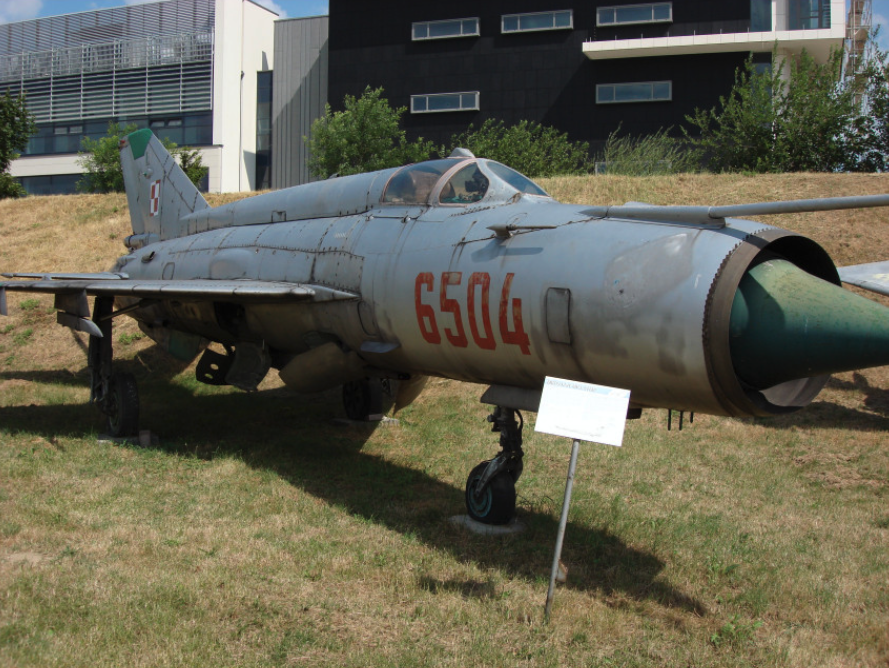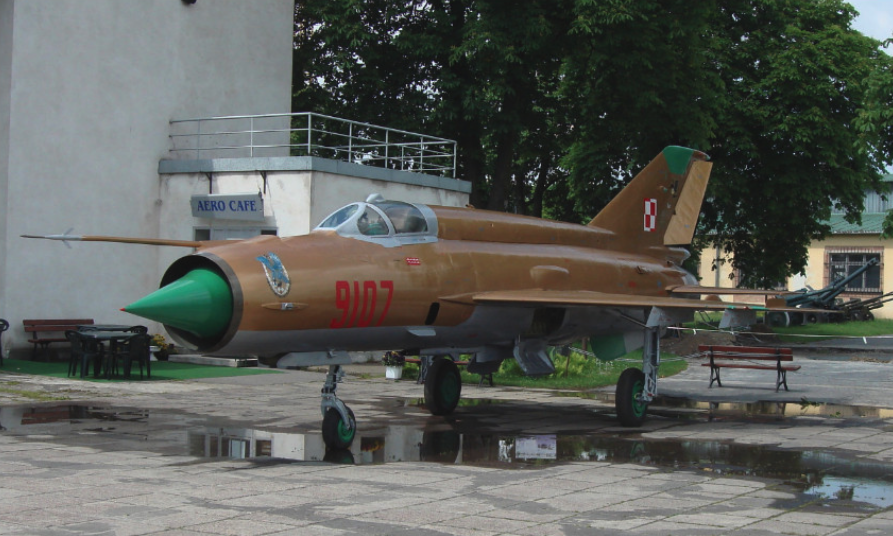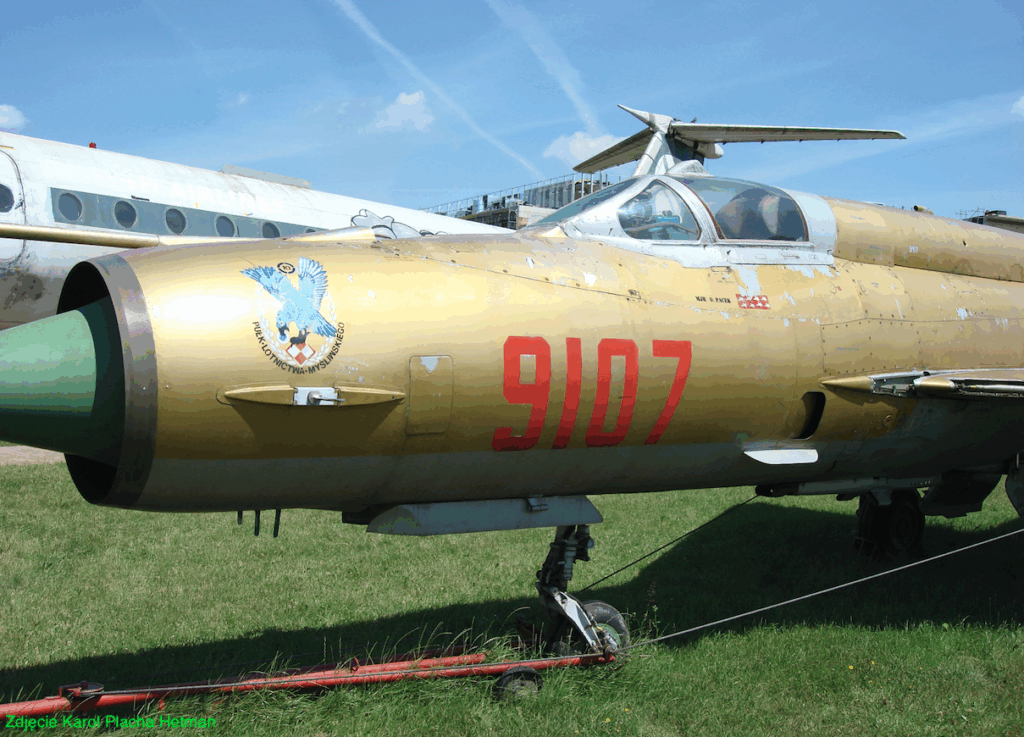Kraków 2007-08-24
232c Rozdział 1961-09-29.
OKB Mikojan i Guriewicz MiG-21 MF w Polsce.
MiG-21 MF to naddźwiękowy samolot myśliwski, działający w „każdych warunkach pogodowych”. Samoloty tej wersji były użytkowane w Polsce w liczbie 120 egzemplarzy.



MiG-21 MF.
MiG-21 MF typ 96 F (A) to zmodernizowany MiG-21 M. Była to wersja eksportowa z silnikiem R-13-300 i poprawionym wyposażeniem. Tak na dobrą sprawę zmiany były niewielkie. W praktyce jednak wiele krajów zakupiło tą wersję zubożoną, a nawet z silnikami R-11. Samolot produkowano w Moskwie w latach 1970-1974 i w Gorki w 1975 roku. MiG-21 MF mimo licznych modyfikacji w stosunku do poprzedników nadal należał do trzeciej generacji samolotów MiG-21.
MiG-21 MF w Polsce. 1972 roku.
Niemal równolegle z MiG-21 M wprowadzono na uzbrojenie samoloty MiG-21 MF typ 96 A. Dostawy trwały od końca 1972 roku, do 1975 roku. W dniu 11.12.1972 roku, dostarczono 9 pierwszych maszyn. Polska kupiła łącznie 120 (inne źródła podają 116) egzemplarzy. W 1990 roku, Wojsko Polskie na uzbrojeniu posiadało jeszcze 106 samolotów w tej wersji.
Kupno samolotów MiG-21 MF może wydawać się dziwny. Kupiliśmy wersje zubożone. Silniki i stacje radiolokacyjne jak w wersji MiG-21 M. (Silnik R-11 F2S-300, stacja radiolokacyjna RP-21 MA). Samoloty mają silniki R-11, zamiast mocniejszych R-13. W tym czasie przemysł CCCP produkował już w dużych ilościach wersję lepszą, MiG-21 bis. W artykule – historia MiG-21 M – staramy się wyjaśnić tą sprawę.
Podczas dostawy przyprowadzono partię MiG-21 MF z CCCP, w których zakwestionowano jakość wykonania płatowca (Liczne usterki. Pofałdowania blach pokrycia kadłuba, gdzie powinny być gładkie. Niejednakowo otwierające się klapy). Dowództwo dywizji odmówiło przyjęcia tych samolotów. Z Malborka odesłano je do producenta. Według nie potwierdzonych informacji samoloty te były początkowo przeznaczone na wojnę w Wietnamie, ale ponieważ się skończyła, samoloty chciano przekazać ( sprzedać ) Polsce. W związku z tym, ostatnia partia 20 maszyn MiG-21 MF została nam dostarczona wyjątkowo z zakładów Gorki. Samoloty te mają nietypowe numery seryjne, z tak zwanym prefiksem 96A00. Samoloty przyjęto 11.12.1975 roku. Samoloty te nie różniły się od wcześnie dostarczonych maszyn MiG-21 MF.
Pierwsze samoloty MiG-21 MF trafiły do 41. PLM w Malborku w latach 1973-1974. Ciekawostką jest fakt, że samoloty MiG-21 M, MF użytkowane w Malborku, jako jedyne w Polsce mogły przenosić k.p.r. klasy p-z Ch-66 oraz zasobniki walki radioelektronicznej WRe SPS-141.
Samoloty MiG-21 MF wprowadzono na wyposażenie 4. PLM w Goleniowie, 10. PLM w Łasku, 11. PLM we Wrocławiu, 26. PLM w Zegrzu Pomorskim, 28. PLM w Słupsku, 34. PLM-MW w Babich Dołach, 41. PLM w Malborku.
W 10. PLM w Łasku samoloty MiG-21 MF, UM zagościły stosunkowo późno. Przeszkolenie na nowy typ przeprowadzono w oparciu o sprzęt z 28. PLM i 34. PLM, z których czasowo wypożyczono samoloty; 10 samolotów MiG-21 MF i 2 samoloty MiG-21 UM. Było to w okresie od lutego do maja 1978 roku. Pułk w Łasku, na własne samoloty musiał poczekać do 1981 roku, kiedy to z 26. PLM z Zegrza Pomorskiego otrzymano 20 samolotów MiG-21 MF. Były to głównie samoloty wyprodukowane w zakładach w Gorki. 10. PLM eksploatował te maszyny do 1989 roku, kiedy to przekazał te samoloty do 11. PLM we Wrocławiu.
W 10. PLM, w 1989 roku, nastąpiły jeszcze inne zmiany. Wycofano z eksploatacji wszystkie samoloty MiG-21 PF, a w ich miejsce wprowadzono starsze niż poprzednio eksploatowane MiG-21 MF, z rozformowanego 2. PLM Kraków w Goleniowie, a także z 41. PLM z Malborka.
W okresie od listopada 1989 roku do marca 1990 roku, 62. PLM otrzymał z innych pułków samoloty MiG-21 MF, w liczbie 24 maszyn. Głównie z 11. PLM z Wrocławia. Samoloty miały po 15-18 lat, a ich awaryjność była wysoka. Dlatego wiosną 1991 roku, podjęto decyzję o przywróceniu do służby starszej wersji MiG-21 PFM. Eksploatowane przez ponad rok MiG-21 MF przekazano do 10. PLM w Łasku i 11. PLM we Wrocławiu.
W 1991 roku, na stanie 45. Lotniczej Eskadry Doświadczalnej w Modlinie był 1 samolot MiG-21 MF.
W okresie od 1991 roku do 1996 roku, 10. PLM w Łasku przejął prawie połowę pozostających w użyciu samolotów MiG-21 MF.
W sierpniu 1998 roku, dowództwo wojsk lotniczych zdecydowało się na kolejną rotację pozostających w eksploatacji samolotów MiG-21. W październiku 1998 roku, do 3. PLM ( eks 62 ) w Krzesinach trafiły samoloty MiG-21 MF z 41. PLM w Malborku. Czyli po raz drugi w Krzesinach zagościły samoloty MiG-21 MF.
W 1999 roku, rozformowano 11. PLM z Wrocławia. Wszystkie sprawne samoloty MiG-21 MF przekazano do 3. PLM i 10. PLM w Łasku. Dzięki temu wszystkie będące jeszcze w użyciu MiG-21 MF skupiono w tych dwóch pułkach.
W 1999 roku, Polska została przyjęta do NATO. Efektem była zmiana struktury lotnictwa. W miejsce pułków powołano eskadry i bazy lotnicze.
W dniu 1.01.2001 roku, przestał istnieć 3. PLM, a w jego miejsce powstała 3. ELT i 31. BLot. 3. ELT dysponowała w tym czasie kilkunastoma samolotami MiG-21 MF, które eksploatowano do drugiej połowy 2002 roku.
Na przełomie 2002/2003 roku wszystkie samoloty MiG-21 wycofano z użycia. W czasie służby utracono 20 sztuk MiG-21 MF ( 3 w katastrofach, 16 w awariach, 1 z powodu uszkodzenia).
Możliwości bojowe MiG-21 MF.
Należy przyznać, że były różnice w możliwościach bojowych Polskich MiG-21 MF, a rosyjskich MiG-21 MF i nie chodzi tu tylko o silniki. Znaleźliśmy taką wypowiedź jednego z byłych pilotów MiG-21; „Podam mały przykładzik z osobistego doświadczenia. W Astrachaniu zdarzyło mi się wykonać dwa loty na „ich” samolotach MiG-21 MF. W trakcie ćwiczenia taktycznego zdołałem z odległości 3 km przechwycić cel zniżający się z wysokości 1 200 m do 900 m, a ja byłem nad nim i też się zniżałem! Ledwo go było widać wśród zakłóceń od ziemi, a kurzawa od burzy piaskowej sięgała do tej wysokości, tak, że o wzrokowym wykryciu można było zapomnieć. Ponad 17 lat latałem na MiG-21, przez 14 lat byłem ssp i powiem tak: żaden samolot w Polsce, nawet nowiutki ( bo i na takich latałem ) nie zdołałby tego dokonać, nawet gdybym wdział go wzrokowo i postawił na nim siatkę celownika optycznego.” Były to lata 80-te. Świadczy to o tym, że sowieci stale modernizowali swoje wyposażenie awioniczne. Do użytkowanych stacji radiolokacyjnych wgrywali nowe poprawione algorytmy. Czy oferowali modernizacje stronie Polskiej, tego nie wiadomo. Lecz na pewno trzeba byłoby za to zapłacić.
Do początku 1981 roku samoloty MiG-21 M / MF, w ramach dyżuru bojowego, przygotowane były w pełnym uzbrojeniu; 2 x RS-2 US + 2 x R-3 S + 200 szt. amunicji do działka. W 1981 roku zmieniono to i parę dyżurną wystawiano tak, że jeden samolot miał 2 x RS-2 US, a drugi w 2 x R-3 S. Dodatkowa para pocisków była umieszczana na stojakach przy samolotach. Amunicja do działka pozostała bez zmian. Sami piloci nie bardzo rozumieli tę zmianę, ale wprowadziło to zamieszanie.
MiG-21 MF stosunkowo szybko (90-lata XX wieku) wycofano ze służby w byłych krajach „demokracji ludowej”. Ale był jeden wyjątek, jakim była Rumunia. Kraj ten jako jedyny zdecydował się na modernizację swoich samolotów MiG-21. Decyzje zapadły około 1992 roku. Rumunia podjęła współpracę z izraelskimi firmami Aerostar (specjalizacja – bezzałogowe statki powietrzna) oraz Elbit Systems. Daleko idąca modernizacja objęła samoloty MiG-21 M/MF/bis/UM. Na ich bazie powstały samoloty oznaczone MiG-21 Lancer, które zmodyfikowano w trzy wersje: Lancer A – przeznaczone do misji bliskiego wsparcia wojsk naziemnych, Lancer B – szturmowy, dwumiejscowy, Lancer C – myśliwiec przewagi powietrznej, który wyposażono w izraelską stacją radiolokacyjną Elta EL/M 2032. Tłem modernizacji było dostosowanie samolotów do standardów Zachodnich, pozwalających na współprace z samolotami NATO. Maszyny otrzymały możliwość przenoszenia pocisków klasy p-p R-73 i Python 3 oraz zasobników celownico-rozpoznawczych Rafael Litening. Łącznie zmodernizowano 36 maszyn. Pierwsza z tych maszyn wzbiła się w powietrze w dniu 23.08.1995 roku. Samoloty MiG Lancer mogliśmy oglądać w Rzeczypospolitej w Radomiu w 2015 roku, akurat w 20 rocznicę ich wprowadzenia do służby. Maszyny prezentowano na wystawie statycznej i w powietrzu. Był to jeden z ich ostatnich pokazów samolotów Lancer, ponieważ kilka miesięcy później Rumunia pozyskała z Portugalii samoloty General Dynamics F-16 A/B Blok 15 MLU, które poddano modyfikacji.
Opracował Karol Placha Hetman
